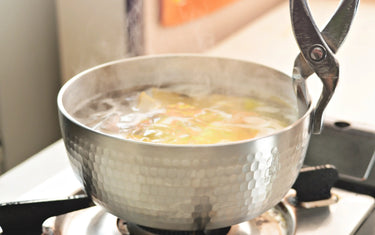Handles on pots are handy when it comes to carrying them, but not so practical when cooking on a stove or storing. You might tip over the pot by bumping the handle. Handles also take extra space in your storage.
Yet most cookware has handles sticking out. They are not very convenient when it comes to cooking in a small kitchen or storing them in a small storage space.
Today we will share this Japanese traditional pot called "Yattoko pot" that can solve all those problems related to handles.
The products we used:
What is a Yattoko pot?

A Yattoko pot is a pot without a handle that can be lifted or carried with Yattoko pincers.
Yattoko pincers are pliers-like tools made of cast iron, specially made for Yattoko pots.
Since a Yattoko pot doesn't have a handle, we grab it by pinching its edge with Yattoko pincers when we want to lift it or move it.
Like pliers, Yattoko pincers work on the principle of a lever that enables a strong grip with a little force. They can thus grip and move a heavy pot even with soup or stew inside.
In Japan, many chefs have been using Yattoko pots for many centuries.
Highly functional Yattoko pots are still well-appreciated today especially in restaurants where it is important to work efficiently. They also have many cooking utensils, so Yattoko pots can save storage space.
Easy to handle and functional, a Yattoko pot is also a great cookware for home.
Benefits of using Yattoko pots

One of the great benefits of using Yattoko pots is that they take less space when cooking or storing, because they don't have handles. No need to worry about burning the handles when cooking them on high heat either.
Another benefit is that it takes less time to clean thanks to its simple form. They can be kept clean for storage since grease and grime usually accumulate easily on the handles.
Like Yukihira pots, Yattoko pots distribute heat fast and evenly. You can thus save time for cooking. You don't need to worry about burning your sauce or stew either.
No wonder many chefs prefer using Yattoko pots.
How to use Yattoko pots

Since they don't have handles, Yattoko pots are lifted or moved with Yattoko pincers.
Yattoko pincers work on the principle of a lever just like pliers, gripping the pot firmly. Even without a handle, you can lift and move the pot as you like, allowing you to cook like with any other pots with handles.
Except for the fact that you need to have Yattoko pincers, you can cook with them just like when you cook with other pots that have handles.
How to store Yattoko pots

Yattoko pots come in different sizes depending on use. You can easily stack pots in different sizes for storage since they have no handle. You can thus save the storage space.
Wash and dry them thoroughly before stacking them. If they are stored with moisture, it can cause them to rust.
Further instructions

Yattoko pots come in different materials, such as aluminium or stainless steel. In either case, wash them gently with a soft sponge and dish soap after each use, and then dry them thoroughly.
Avoid using abrasive tools such as steel wire wool or hard scrub brushes as these can damage the surface, which can lead them to rust.
Most Yattoko pots in aluminium are not anodized, they may discolor as you use them.
If that happens, the discoloration will fade naturally as you continue using them. But if you want to fix it right away, add something acidic such as lemon or citric acid in water and boil it in the discolored pot.
Turn off the heat once the water has boiled and leave it for a while to cool it down. This can improve the discoloration.
Enjoy cooking efficiently with Yattoko pots
Japanese traditional cookware, Yattoko pots have been part of Japanese culture for a long time. They are still appreciated by many chefs even today.
They have been designed and refined through the history of Japanese cuisine, reaching this highly functional form. It would surely make your cooking easier and more efficient.
We covered the great benefits of using Yattoko pots and how to use them in this article.
Please add Yattoko pots to your kitchen and enjoy a pleasant cooking experience.















